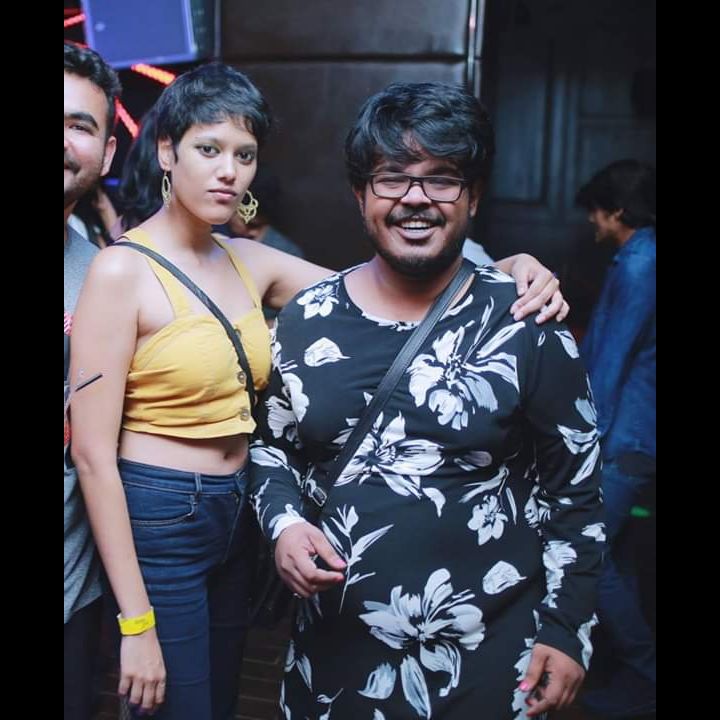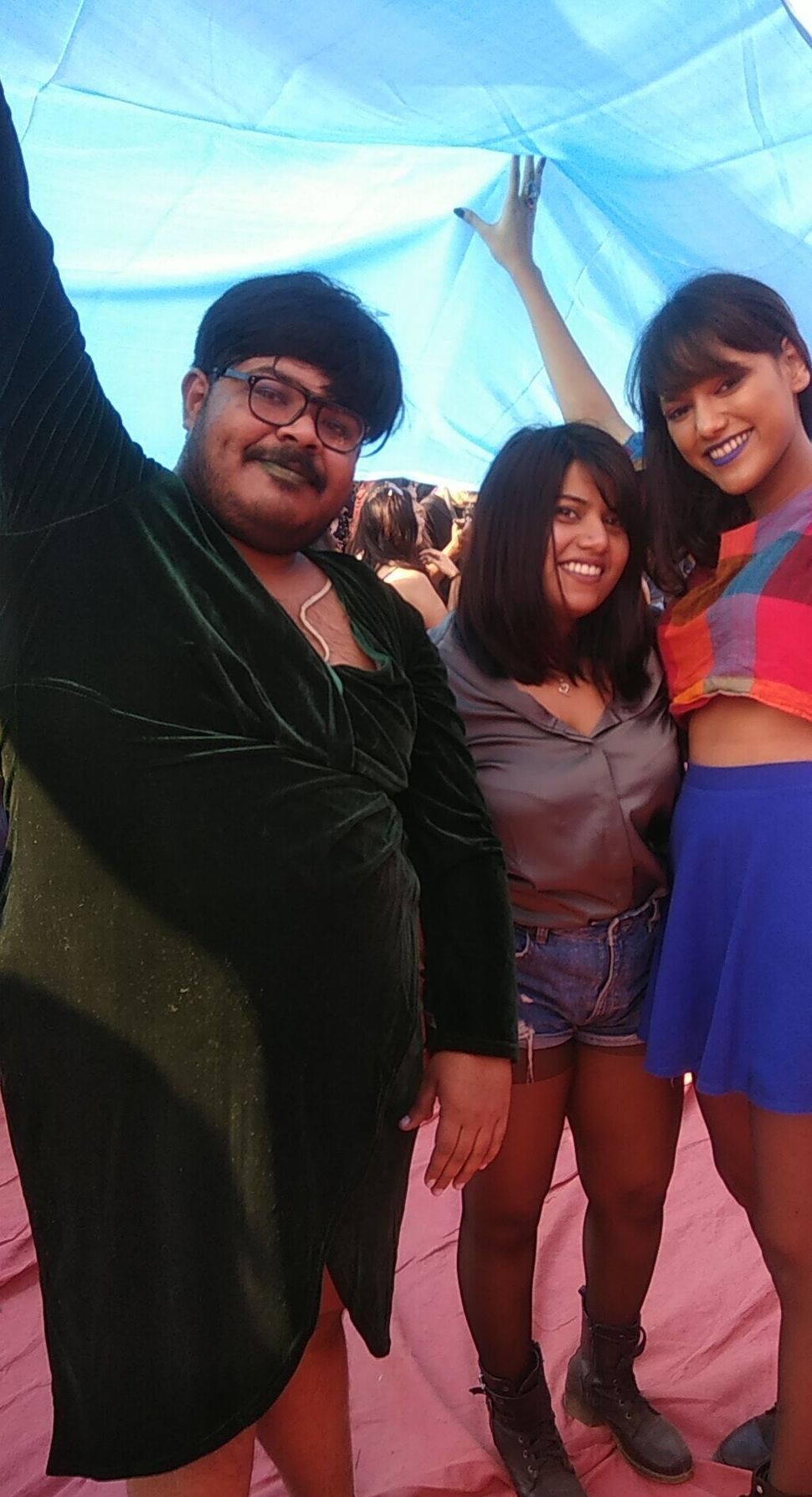
A few days before Valentine’s Day — the week social media is all mush and colour because it is apparently the ‘week of love’ — I posted a picture of myself wearing my favourite black dress on Twitter. The picture went ‘viral’. Only, a majority of the people who retweeted the photo were cis-gender and savarna. Of course, most of them had to ridicule the photo and dehumanise the person in it.
Within hours, I’d received abuses and threats, I had been doxxed and had received 20 calls from unknown numbers. I cried for the night, woke up and went back to my work as a PhD student, in my men’s clothing, because the incident made it clear that if I wanted to desire myself, everyone would despise me.
As far as I can remember, clothing stores in India have always been symbolic of this challenge in my life: this pressure to walk the tightrope between disgust and desire. When I was growing up in Kolkata, all I wanted was to buy a skirt and wear it. I used to wistfully look at the beautiful women in their swirling sarees and flowing skirts on Oshtomi mornings and Saraswati Puja and yearn to have those clothes, to be in those clothes. However, my mother would never let me buy one.
The first time I remember asking her was when I was 15. I wanted a shirt at the women’s section, it was pink and had flowers all over it. But my mom sternly told me that it was a women’s shirt and I am not supposed to wear it. Years later, once when I was home after graduating, my mother instructed me to wash my clothes myself, and make sure that my father did not see them.
She said this after spotting the first dress I had bought, in a pile of ‘men’s’ clothing. I was 19, and after I’d moved away from home with the money I earned from freelancing, I managed to buy a dress.
I was still too scared to visit brick-and-mortar shops in Ranchi where I studied, so I bought it online.
My fears about visiting actual shops were neither unfounded, nor quelled over the years. In fact, my experience at chain shopping stores and malls only confirmed the fears of my youth.
I have been unceremoniously shown out of mega-stores, several times.
A few years ago, the 21-year old me found myself at a Lifestyle store in Pune, and as I wandered around the women’s section simply touching dresses occasionally to check the texture, a male staff sternly told me to not loiter around or touch women’s clothes. I was dressed in a kurti and jeans, my go-to attire for going out.

That was not the first time something like this happened and that wasn’t the last either. I’d like to think these interventions are innocuous. For example I don’t want to blame the Colorbar employee in Kolkata for constantly insisting that the lipstick I was buying was for my ‘girlfriend’. Not to mention, I had tried on the lipstick in front of him and was giggling with my friend about how good it looked, but he seemed almost desperate to not accept what he saw.
And I don’t want to be angry at the Pantaloons employee at Kolkata, who followed me around all the time I was checking clothes out at the women’s section and told me I should not touch them.
The first time I made an attempt to try on a dress at a mall was three years ago. I was at the Shopper’s Stop, at South City Mall in Kolkata. It was a weekend and a steady stream of people poured into the mall for the ongoing sale. When my non-binary friend went in to try her dress, I picked up a dress I really liked and followed her to queue before the women’s trial rooms.
“I had tried on the lipstick in front of him and was giggling with my friend about how good it looked, but, he seemed almost desperate to not accept what he saw.”
But the attendant impassively told me that I could not try a dress on. I remember being angry. Angry, especially at my friend who was assigned womanhood at birth, and despite being non-binary, could try on a shirt from the men’s section that I picked out for them.
We didn’t fight back, most times we don’t. When I and my trans friend who could ‘pass off as a woman’ visited a store in Linking Road in Mumbai back in 2018, the shopkeeper said that the jeans were for women and I couldn’t buy them. I was 22 then, and I spent hours at that time being angry, not at the shopkeepers and the girls who worked at the store, but at the trans girl who took me there, giving me hope.
Clothing is a strange tightrope that the entire trans community walks around these times. For many women who identify themselves as part of the hijra community, their clothing is only given to them after much persuasion. One girl I knew only got her salwar kameez after she threatened the shopkeeper that she’d curse him. The shopkeeper didn’t think that she had the money to buy the clothes she wanted and refused to even listen to her.
SILVER LININGS
So how do we shop? Discreetly, online, mostly. Over the last year, I have done most of my shopping online. Trans friends who have a penchant for wearing sarees often order from boutiques they spot on Instagram, or from big, impersonal wholesale markets where they pretend they are buying them for someone else. Big markets — where shopkeepers are too busy, and often keen on business, to indulge in elaborate personal interactions — provide trans people the opportunity to shop what they want without being obviously ridiculed.
Yet, we find kindness and acceptance in the places we least expect to be inclusive or politically correct. My non-binary friend V gets their clothes stitched at a tailor because readymade shirts at the women’s sections make her feel dysphoric. When I used to visit the bustling Gariahat market in south Kolkata as a teenager, I remember a small store near Triangular Park where an uncle has always given me clothes without asking me any questions. Over the years, I have bought most of my Indian wear blouses and salwar pieces from him.
I found him through a trans friend who has been visiting the guy for about half a decade. We were his “special” customers (mostly because my friend was a loyal one) and we talked about everything. It’s been a year since I’ve been in Kolkata, but, I think he still commutes daily to Ballygunge and walks to the roadside shop. He has been selling trinkets and blouse pieces for a long time, and if you’re a trans person you can stop and have a chat with him.
My non-binary friend and I regularly shop clothes at JBS Enterprises, which sells its wares just a stone’s throw away from the sprawling government shopping complex Dakshinapan dotted with state emporiums. Known as the place to find classy, though slightly overpriced, sarees and textiles, shopkeepers at the complex once flatly refused to show me clothes. My crime? I had turned up in a dress.
It was doubly hurtful. I had grown up in the middle-class Bengali neighbourhood around the complex and had often walked around the line of shops stacked with the most exquisite dhakais, the softest tussars and flimsy cotton sarees with wide-eyed fascination as a child. But when I walked into the shopping center wearing a dress, I was treated like a second class citizen and the shopkeepers simply refused to show me clothes.
I stood on the sprawling patio confused and humiliated for thirty minutes and then walked across the street to JBS Enterprises. This small shop in Kolkata sells factory rejects from various brands. The fit may be a little off at times, but the place has mind-boggling variety. The person manning the shop is a warm, smiling woman who helps you no matter who you are. Over time we’ve become friends, talking about the outfits that look good on me, and how I should dress for particular occasions.
“I stood on the sprawling patio of Dakshinapan confused and humiliated for thirty minutes and then walked across the street to JBS Enterprises.”
For Delhi friends, they buy their new jewelry and clothes from Palika or Sarojini. They are not especially friendly places, but, it’s easy to find contacts within the community who knows someone who knows some shopkeeper. Old markets that rely on friendships and relationships fostered over years can prove advantageous for trans women trying to find roots because there is familiarity here. Also, these are places where a simple conversation can open doors that were closed.
I felt the same sense of confidence while shopping in Lucknow when I was around 16. I rode pillion on my cousin’s scooty to get to the shops which sold colorful bangles and gorgeous jhumkas. We talked for a long while (mostly with my cousin egging me on) about the different pairs that would suit me, and the pairs that my boyfriend at the time would like. Two hours later, I had five pieces of jewelry and a heart full of happiness.
For most trans women, these places have become the heart of their shopping sprees, a way to feel welcome, even if they aren’t. My friends in Poona visit M.G. Road for ballerinas, and I got my first pair of women’s boots from Linking Road. I get my dream clothes stitched at an uncle near F.C. Road in Poona.
The first time I met this uncle to get a dress stitched, he asked me why I wanted to wear these clothes. I simply said, I liked them. He did not ask any more questions and went on to take measurements and mildly chastise me for buying the worst fabrics ever. I had ordered them off Amazon, and they, like he said, were unflattering.
Over the next few weeks, as we often exchanged notes about the clothes he was making for me, he patiently taught me about the different kinds of fabric and how I should care for them.
A year back, a friend who is a trans man started binding as a regular practice. He began using a roll of bandages on his chest and that started causing him breathing problems. However, binders weren’t available quickly, especially ones which were customized to his size. So, he turned towards a local tailor to get a binder, and now he can finally breathe. With research, a lot of photos about binding, and measurements, the tailor chacha made him a tube top which let him breathe and worked as a binder all the same
However, breathing problems are not the only thing that comes with improper clothing. Some trans women complain of having trouble getting bras and other intimates because most shops won’t sell it to them. They also turn to readymade clothing shops at the streetside.
The situation is changing, but it has been slow for many years now. With new clothing designers coming up with brands that are not only comfortable for both genders, but there is also hope. But, till every trans person can afford them and more places welcome walk-ins, the fight is on.
For the latest news and more, follow HuffPost India on Twitter, Facebook, and subscribe to our newsletter.